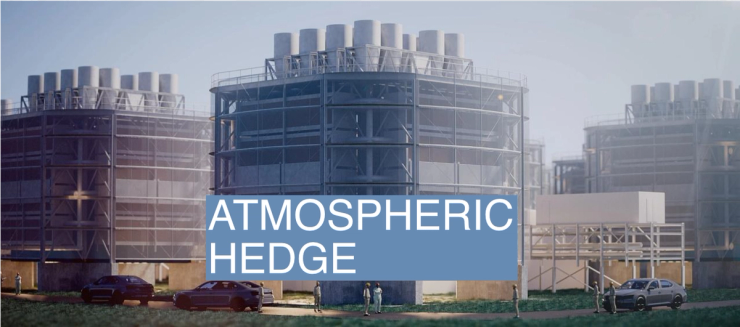The News
Tech to remove carbon dioxide from the atmosphere took a big step forward this week, but remains far off course to reach the levels scientists believe will be necessary to keep global temperatures within the Paris Agreement targets.
Climeworks, a Swiss startup that was among the first companies to build a commercial-scale direct air capture (DAC) plant, switched on the world’s largest such facility in Iceland last month. Yesterday, the company unveiled a series of incremental improvements that it says will allow it to capture twice as much CO2 for half the cost and half the energy consumption of its existing tech. Climeworks plans to build its first “generation 3” facility in Louisiana, part of a project that was awarded a $50 million grant from the US Department of Energy in March.
While Climeworks’ first two plants together are capable of pulling about 40,000 tons of CO2 from the air annually — about 1% of the emissions of a typical coal-fired power plant — the new tech will put the company within reach of hitting several million tons per year by 2030 and a billion tons by 2050, co-founder and co-CEO Jan Wurzbacher told reporters.
In this article:
Tim’s view
It’s no surprise that Wurzbacher is bullish on carbon removal. But the company’s own cost forecasts, plus all of the other available evidence about how quickly the nascent industry can mature, suggest that without much more direct government intervention to force high-emitting companies to pay up for carbon removal credits, there will likely be a major shortfall in the availability of carbon removal by midcentury. Carbon removal tech breakthroughs don’t fundamentally make them a more feasible hedge against slow emissions reductions.
Today there are about two billion tons of CO2 being proactively removed from the atmosphere each year, about 99% of which are carried out through tree-planting programs, according to an in-depth survey of the carbon removal industry this week by the University of Oxford’s Smith School of Enterprise and the Environment. Depending on how quickly renewable energy and electric vehicles can roll out, and how sensitive the climate really is to greenhouse gas emissions, by 2050 there will likely be about 7 to 9 billion tons per year that need to be mopped up. On its current path, the report concludes, the carbon removal industry will fall about 5.5 billion tons short of that target. High costs are one limitation, and the shortage of clean electricity to run carbon removal facilities is another. The industry also faces sustainability-related conflicts, like running out of room to plant trees or crops for carbon-sucking purposes because they cut into food supplies or pose threats to biodiversity. There’s also a shortage of funding for early-stage carbon removal startups, which attract just 1.1% of climate tech investment, the report found. Add all these up, and claims by carbon removal startups that they’ll be able to close the midcentury gap show “little grounds for credibility at present,” the report says.
Climeworks says that its latest innovations will bring its costs from intergalactic — nearly $1,500 per ton — to merely stratospheric, around $800, by 2027, and below $600 by 2030. But in the company’s forecast the pace of cost improvements slows after that, reaching just below $250 by 2050. That’s pretty steep when forestry carbon removal is less than $20 today, and other methods are available today for between $100 and $400.
For now, Climeworks has been able to justify the buildout of its early plants as necessary first steps down the cost curve, helped along by government grants, tax breaks, and a small cohort of deep-pocketed tech-company buyers willing to shell out. But Wurzbacher warned that moving forward, the company is running out of headroom to build plants it can’t turn a profit from. “It needs to make sense to invest large sums of capital,” he said. “We’ll only be able to finance future plants if they are profitable.”
The voluntary carbon credit market, which today is carbon removal’s only real market, is totally insufficient for driving the kind of purchasing necessary to make those profits — and, thereby, a scalable carbon removal industry — a reality, said Wil Burns, co-director of the Institute for Responsible Carbon Removal at American University.
“Even poster children like Microsoft have no long-term investment strategy to show how much carbon removal they’re going to purchase,” he said. “So I think there’s a lot of kabuki theater going on from corporations and governments.”
Instead, he said, polluting companies should be mandated to buy carbon removal credits, in a policy known as a “carbon takeback obligation” that’s popular among environmental economists but, in the US at least, not likely to materialize anytime soon. Barring that option, Burns said, the prudent choice is to be extremely conservative about how much help we’ll really be able to count on from carbon removal: “If we rely on this and it doesn’t work out, we’re really screwed.”
Room for Disagreement
Even that interpretation is too generous in some climate tech circles. Kurt House, who co-founded the mineral exploration startup KoBold Metals and previously worked on carbon capture engineering, told Semafor last year that DAC is “catastrophically stupid” because the relatively low concentration of CO2 in the atmosphere means the technology will always be much more expensive than catching CO2 as it emerges from smokestacks or tailpipes. Every dollar spent on DAC, in his view, is a missed chance to invest in more impactful technologies.


